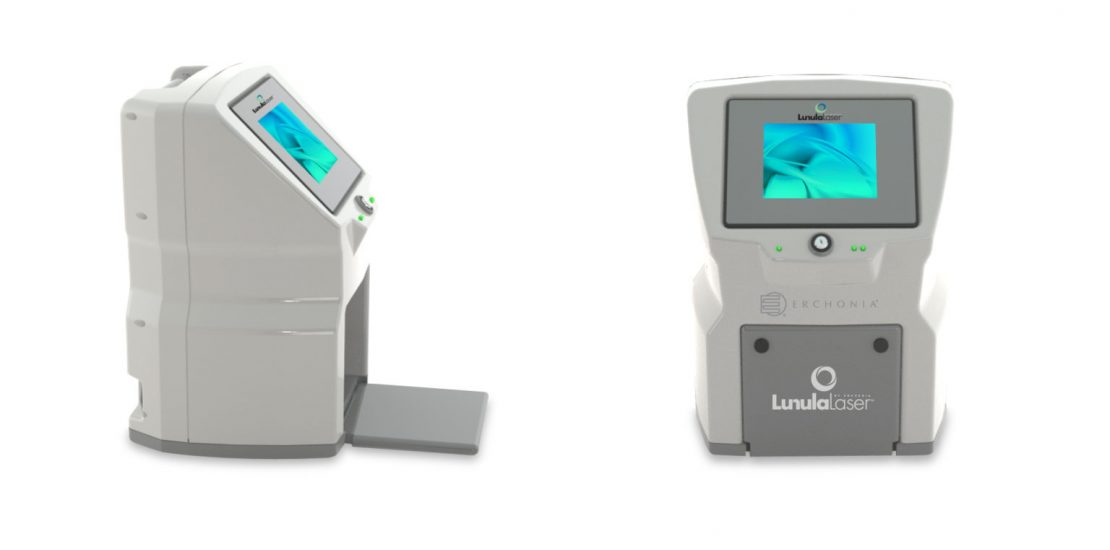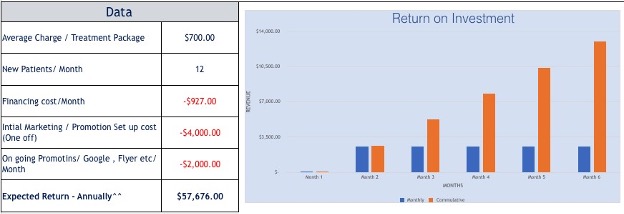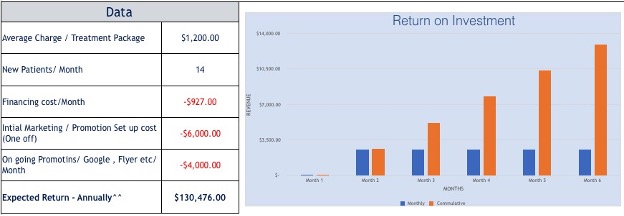What’s the ROI, and is it worth the investment for your clinic?
- January 30, 2021
- Posted by: admin
- Category: Competitive research

The Erchonia™ Lunula laser is an antifungal device designed specifically for treating onychomycosis, fungal infections in the feet of patients, by registered health professionals. It’s USP lies in its use of two unique wavelengths of low-level light, both of which have extensive published studies on their benefits separately, and together as the Lunula laser.
Like any medical or therapeutic device, making the decision as a clinic owner to add the Lunula laser to your service offerings requires careful consideration about the financial return versus the investment cost. This includes variances in marketing budgets to account for new patient acquisition and hence the growth of average monthly treatment numbers. Today, we’re sharing the average returns currently experienced by our clients from small, medium and large clinics across Australia & New Zealand, to help give you an insight into why they consider the Lunula laser an asset to their clinic.
Your clinic’s expected returns
To accurately project your clinic’s returns on the lunula laser, we need to consider a number of factors:
- The average cost per Lunula treatment ‘pack’ of 6x treatment sessions plus follow-up reviews, packaged to ensure patient compliance in attending (and financing) all follow-up sessions. (The normal regime is 4 treatments, and 6 is an average taking into account more severe cases) ● Monthly new patient numbers
- Your initial one-off set-up cost for marketing
- Ongoing monthly promotional and marketing spend
- Your monthly financing costs for the laser
- Your clinic’s socioeconomic area and therefore the differing cost of treatment currently being offered by podiatrists in practice, and the associated variances in marketing and acquisition costs for your patient demographics
We’ve calculated each of these based on a survey of our Lunula laser clients and their reported monthly figures. While initially, we had projected that differences in marketing spend would yield higher/lower new patient acquisition numbers, feedback from our clients found that they generally had a steady new patient numbers but with different treatment and marketing spends that was dictated by their clinic’s location and hence their patient’s demographics. This is how we have categorised these figures (figs. 1, 2, 3).
Socioeconomic Area 1, Treatment Package = $400
On average, clinics located in lower socioeconomic areas were charging $400.00 per Lunula treatment package. This included average 6x 30-minute treatment sessions spaced one week apart, as well as 15minute review appointments to check their patients’ progress monthly following final treatment completion.
Their average one-off marketing spend was $2,500.00 with $500.00 in ongoing monthly advertising costs. They were acquiring an average of 10 new patients per month. After marketing, finance and set-up costs were accounted for, these clinics were returning, on average, almost $26,000 annually.
Fig 1. Annual return on $400.00 treatment packages
Socioeconomic Area 2, Treatment Package = $700
Clinics located in moderate socioeconomic areas were charging, on average, $700.00 per Lunula package. Their average one-off marketing spend was $4,000.00 with $2,000.00 in ongoing monthly advertising costs. They were acquiring an average of 12 new patients per month. After marketing, finance and set-up costs were accounted for, these clinics were returning, on average, almost $58,000 annually.
Fig 2. Annual return with $700.00 treatment packages

Socioeconomic Area 2, Treatment Package = $1,200
Finally, the clinics surveyed that were located in high socioeconomic areas were charging approximately $1,200.00 per Lunula antifungal treatment package. Their average one-off marketing spend was $6,000.00, with $4,000.00 in ongoing monthly advertising costs. They were acquiring an average of 14 new patients per month. After marketing, finance and set-up costs were accounted for, these clinics were returning, on average, over $130,000 annually.
Fig 3. Annual return with $1200.00 treatment packages

Client Survey Feedback
Those clinics surveyed highlighted two key points that they attribute to the success of the Lunula in their practice. The first is the importance of sharing knowledge and managing patient expectations. Clinics at all socioeconomic levels were taking the time to thoroughly explain the fundamentals of fungal nail infections, how it spreads, how to prevent reinfection, and signs to look out for so they could adequately manage their patient’s expectations. This included the potential to need further treatment if the nail becomes reinfected, or if more than four treatments are required due to the severity of the infection.
The second was the importance of packaging the treatments into bundles instead of charging single treatment prices. As with any care, patients who were offered a pay-per-treatment model had lower compliance rates when it came to returning weekly for their appointments, thereby impacting on both the success of the treatment – and the clinic’s profitability.
Interestingly, from a back-end business perspective, the clinics also noted the convenience and benefit of having no ongoing consumables to account for and manage and the very low percentage of any failures or downtime. Rehacare provides a free loan device if a repair is required so that a clinic’s services can continue, and all devices come with a standard two-year warranty period.
Maximising your ROI with your marketing strategy
While the figures we’ve shared with you are based on averages from our existing clients, there is plenty of potential to further improve your return by getting creative with your marketing. All of the clinics we surveyed had engaged in active marketing via platforms like social media and print media to promote the services in their area. Here are five ways that some of our clients are maintaining their new patient streams:
- Google ads – using keyword analysis to create defined ads to be shown to those looking for a solution to discoloured, fungal toenails within a radius of your clinic
- Facebook ads – using knowledge of your target avatar’s characteristics, interests, searches and location to create targeted ads, billed only when they are clicked on to become your lead
- Referral programs – using referral vouchers, discounts and other incentives and strategies to encourage sharing your services with others in the same location and suffering from the same problem
- Nail salons – with the criticism that many nail salons face for their hygiene efforts, many clinics have partnered with their local salons as a referral source. This is appealing to the salons because it shows their customers that they care about safety and hygiene, and are informed about the issues at hand and effective solutions
- Campaigns – specific, targeted campaigns combining emails with an initial offer have also proven successful for many clinics. Examples include a season focus (get your feet ready for summer), an aesthetic focus (don’t hide your toes, wear your sandals with confidence) and marketing directed at adult children for bookings for their older parents
To help support you, the team at Rehacare provide all our clients with basic marketing material and content for the Lunula laser for you to leverage and have a master keyword list to help direct the SEO on your Lunula-specific website pages and Google ads.
Up-sells
Additionally, many clinics are also adding up-sells to the Lunula treatment to further maximise their returns. This includes using UV devices(SteriShoe) to sanitise existing footwear while the patient completes the treatment, selling antifungal products like in-shoe antifungal sprays and detergents to hot wash their socks and sheets, and even new socks to wear immediately after the treatment to promote a clean environment following the treatment.
The Lunula treatment process: An overview
If you’re unfamiliar with what a Lunula laser treatment session looks like and what you can expect, here’s a typical overview:
Information, suitability & consent
During the first appointment, you complete your patient’s history, record their complaint, and examine their toenails to ensure that the laser is a suitable treatment option for them based on your clinical judgement.
As fungal nail infections are often longstanding and have distinct signs, this is a straightforward process. Some clinics choose to offer an in-house test to confirm the presence of fungal nail infection, charged additionally. All questions are answered, full information is disclosed, and patient consent for the treatment is attained. Photos are taken for visual progress documentation.
Debridement
Next, debridement occurs. This involves trimming the toenails to minimise the surface area, reducing any thickening using a burr, and clearing the sides of the toenail with a black’s file. Following this, each foot is placed inside the Lunula laser device, where a painless 12-minute treatment cycle is completed per foot. This is free of discomfort or any side effects, and this time can be taken to talk your patients through their after-care, what to expect, and how to minimise their risk of reinfection.
Follow-up appointments
Most patients require multiple treatments; typically, four sessions spaced one week apart. At each session, the laser treatment is repeated on both feet. If the infection is severe, more than four sessions may be required.
After completing the weekly sessions, a follow-up appointment is scheduled monthly reviews, either by clinic visit or an iPhone picture of the nails from the patient to check on progress. At this short appointment, patient progress is photographically documented, patient compliance with reinfection protocol is discussed, and the results are discussed. At this stage, you can usually notice some clear nail growth at the base of the nail. Further follow-up appointments are scheduled at your discretion. If reinfection occurs, your patient may require further treatment sessions.
The verdict on Lunula laser?
Speaking with our clients, we’ve had many patients describe Lunula as one of the “best investments we have made in our podiatry clinic“. While there are many external factors and business conditions that may affect individual returns, the cost of the laser is quickly absorbed, requiring little time to start profiting from the device. Given the ease of use of the device, which does not require ‘hands-on’ care from the practitioner during operation, the Lunula laser is an excellent addition to clinics of all sizes.
Need more information on the Lunula laser or wanting to speak with someone about how the Lunula laser could fit in with your clinic and offerings? Contact us at Rehacare on 1300 653 522 or at info@rehacare.com.au.
- Growth through innovation/creativity:
Rather than be constrained by ideas for new products, services and new markets coming from just a few people, a Thinking Corporation can tap into the employees. - Increased profits:
The corporation will experience an increase in profits due to savings in operating costs as well as sales from new products, services and ventures.
- Higher business values:
The link between profits and business value means that the moment a corporation creates a new sustainable level of profit, the business value is adjusted accordingly. - Lower staff turnover:
This, combined with the culture that must exist for innovation and creativity to flourish, means that new employees will be attracted to the organization.


